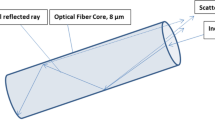Conclusions
Buried fiber intrusion detection by calculating the changes in the spatial distribution of energy in the output of a multimode optical fiber has been demonstrated. An analysis and experimental demonstrations of the system have been provided in which we observed that by using the very simple technique of speckle pattern analysis using image processing we could detect various intrusions. The system can be used to detect the passage of vehicles and personnel over buried sensing fibers. The non-electrical nature of the sensor would allow it to be undetectable by the intruder, and the low loss nature of fiber optics would allow the signal processing location to be located at a large distance from the actual sensor. The complete hardware utilized in this effort is one that can be realized at low cost. The same technique can be used in many other sensing applications like temperature sensing, pressure sensing, any kind of vibration sensing etc. Further improvements in the design can be planned using neural network and advanced image processing algorithms such that only human intrusions are separated from other (nuisance) intrusion signals.
Similar content being viewed by others
References
Butter, C.D., Hocker, G.B. “Fiber Optics Strain Gauge,” Applied Optics 17, 2867–2869 (1978).
Culshaw, B., Davies, D.E.N., Kingsley, S.A. “Acoustic Sensitivity of Optical-Fiber Waveguides,” Electron. Lett. 13, 760–765 (1977).
Claus, R.O., Bennett, K.D., Vengsarkar, A.M., Murphy, K.A. “Embedded Optical Fiber Sensors for Materials Evolution,” J. Nondestructive Evaluation 8, 135–145 (1989).
Blake, J.N., Huang, S.Y., Kim, B.Y., Shaw, H.J. “Strain Effects on Highly Elliptical Core Two-Mode Fibers,” Optical Letters. 12, 732–734 (1987).
Cohen, L.G. “Pulse Transmission Measurements for Determining Near Optimal Profile Gratings in Multimode Borosilicate Optical Fibers,” App. Opt. Vol. 15, 1808–1814 (1976).
Pan, K., Uang, C-M., Cheng, F., Yu, F.T.S. “Multimode Fiber Sensing by using Mean-Absolute Speckle-Intensity Variation,” Applied Optics Vol. 33 No. 10, 2095–2098 (1994).
Spillman, Jr. W.B., Kline, B.R., Maurice, L.B., Fuhr, P.L. “Statistical-Mode Sensor for Fiber Optic Vibration Sensing Uses,” App. Opt. Vol. 28, No. 15, 3166–3176 (1989)
Yu, F.T.S., Zhang, J., Pan, K., Zhao, D., Ruffin, P.B. “Fiber Vibration Sensor that uses the Speckle Contrast Ratio,” Optical Engineering Vol. 34, No. 1, 236–239 (1995).
Henao, R., Pomarico, J.A., Russo, N., Torroba, R.D., Trivi, M. “Multimode Optical Fiber Core Measurement by Speckle Correlation,” Optical Engineering Vol. 35, No. 1, 26–30 (1996).
Leng, J.S., Asundi, A., “NDE of Smart Structures using Multimode Fiber Optic Vibration Sensor,” NDT & E International Vol. 35, 45–51 (2002).
Hamed, A.M., El-Ghandoor, H., El-Diasty, F., Saudy, M. “Analysis of Speckle Images to Assess Surface Roughness,” Optics & Laser Technology Article in press, accepted 10 September 2003, Available online at http://www.sciencedirect.com
Author information
Authors and Affiliations
Rights and permissions
About this article
Cite this article
Dhall, A., Chhabra, J.K. & Aulakh, N.S. Intrusion detection system based on speckle pattern analysis. Exp Tech 29, 25–31 (2005). https://doi.org/10.1111/j.1747-1567.2005.tb00200.x
Published:
Issue Date:
DOI: https://doi.org/10.1111/j.1747-1567.2005.tb00200.x




